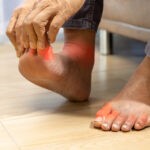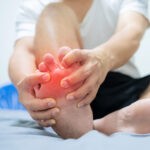Foot and Ankle
Hallux Rigidus

Your big toes help you maintain balance. They receive a huge amount of stress each time you walk, stand, squat, or climb stairs. People with degenerative arthritis may develop a condition called hallux rigidus, meaning a “stiff big toe.” Hallux rigidus occurs when the joint at the base of the big toe wears down and […]
Read More....Mallet Toe

Mallet toe most commonly affects the longest toe on the foot, although any toe can be affected. It causes the joint closest to the tip of the toe to bend downward. Mallet toe is most frequently caused by structural problems in the toe or from wearing poor fitting shoes. It is important to diagnose and […]
Read More....Hammer Toe

Hammertoe most commonly affects the second toe on the foot. It is frequently caused by structural problems in the toe or from wearing poor fitting shoes. It is important to diagnose and treat hammertoe early because the condition tends to become worse over time. If left untreated, hammertoe can require surgery. Hammer Toe Symptoms The […]
Read More....Toe Fractures

Your toes are part of your forefoot. Your big toe (hallux) contains two bones (phalanges). The rest of your toes contain three bones. Your toes help you balance and walk. Toe fractures can usually hurt, but they are rarely incapacitating. They most frequently result from some type of trauma. Toe Fracture Symptoms Toe fractures can […]
Read More....Morton’s Neuroma

Morton’s Neuroma is a painful foot condition. It occurs when a nerve near the toes becomes compressed and inflamed. People with bunions, flat feet, and hammertoes are susceptible to developing Morton’s Neuroma. Pressure from standing, walking, jumping and running or wearing high heeled, pointed toe, or tight-fitting shoes can contribute to the condition. High impact […]
Read More....Metatarsal (Forefoot) Fracture

Your forefoot acts as a springboard with each step you take, and a cushion when your foot touches the ground. The metatarsal bones located in the forefoot bear and shift your body weight to help maintain balance. Jumping, twisting, dancing, and running add even more force to the forefoot, making the bones vulnerable to fracture […]
Read More....Lisfranc Dislocation

A Lisfranc fracture occurs in the bones of the midfoot. The fracture results from dropping something heavy on the foot or twisting the foot during sports or in a car accident. If you suspect you have a Lisfranc fracture, you should see your doctor right away for prompt treatment. Some Lisfranc fractures can heal with […]
Read More....Heel Fracture

It takes a lot of force to fracture or break the bones in the heel (hindfoot). Injuries most frequently result from car crashes or falls from a significant height. Fractures may occur in the heel or the bone located on top of the heel. Heel Fracture Symptoms Heel fractures cause pain, swelling, stiffness, and bruising. […]
Read More....Heel Spurs

Heel spurs are abnormal bony growths that develop at the back of or under the heel. Inflammation around a spur can cause significant pain. Fortunately, symptoms can be eased with non-surgical treatments for most people. Heel Spur Symptoms You might not experience symptoms with heel spurs. Symptoms are usually related to the plantar fasciitis. You […]
Read More....Plantar Fasciitis

Plantar fasciitis is a painful foot condition that occurs when connective tissue at the bottom of the foot, called the plantar fascia, is irritated and inflamed. The condition commonly occurs among people who spend a lot of time on their feet. Plantar Fasciitis Symptoms Plantar fasciitis can cause significant heel pain. Heel pain that occurs […]
Read More....




